|
In the oceans coral reefs, the Sea Urchin takes on an important role of protecting stony corals from overgrowth by fast-growing algae. That's right, the ocean's natural algae-control on coral reefs is happily carried out by sea urchins. In many forms of aquariums there are species of slow moving urchins that are perfect for marine aquariums and are totaly reef-safe for reef tanks. They are a unique and interesting invertebrate's, which consume unwanted detritus and help to rid aquariums of undesirable turf and hair algae which are forms of algae that most fish turn there nose up on, finding the algae barely palatable. If not controlled these algae forms can turn an area into an "algae carpet", resistant to elimination by most algae grazers. Really, the only sure method for tight control of the hairy/turfy algae is to add one or more sea urchins to your aquarium.
|
Purple Short Spine Pin Cushion Urchin
Pseudoboletia sp
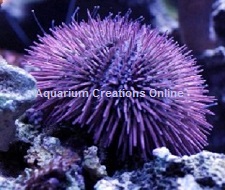
Description:
The Purple Short Spine Pin Cushion Urchin is a small Urchin that has sharp protruding spines. They grow to only 2-3 inches. In Nature, these spines serve as their defense mechanism from predators. This species thrives best in tanks with plenty of live rock to explore and feed off of. During the day, the Purple Pin Cushion Urchin will find a corner or hiding spot to rest. At night, they will roam about the tank searching for food and algae on the substrate, rockwork, and glass. Like other Urchins, the Black Long Spine Urchin can be a good water quality indicator species as its spines will fall out if water quality is poor. Provide an aquarium with ample hiding places and room to roam.
Diet and Feeding:
If there is insufficient algae growing in the aquarium for the Urchin to graze on, the diet should be supplemented with dried seaweed.
Reef Compatibility:
Excellent will not harm inverts or corals
Level of Care:
Easy
Approximate Purchase Size:
Small: 1" to 1-1/2"; Medium: 1-1/2" to 2"; Large: 2" to 3"
|
Small $21.99
Medium $25.99
Large $32.99
|
Black Longspine Urchin
Diadema setosum
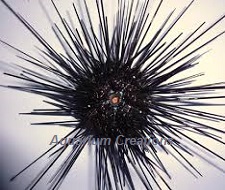
Description:
The Black Long Spine Urchin is a useful invertebrate that can be incredibly beneficial in helping control an algae problem as they are avid algae grazers. This species thrives best in tanks with plenty of live rock to explore and feed off of. They have long, thin black spines that extend from their body, and rows of blue spots in a symetrical design across its body. The anus of the long spine urchin looks like an eye on the top of the body, with a bright orange ring in the center. While the body itself is usually only about 2 to 3 inches in diameter, the spines can grow two to three times this length. During the day, urchins will find a corner or hiding spot to rest. At night, they will roam about the tank searching for food and algae on the substrate, rockwork, and glass. The most common injuries from urchins happens when the aquarists accidently bumps against an urchin and gets poked by its spines so always take care around your urchin to avoid injuring it or yourself. Their spines are mildly poisonous and can cause a slight skin reaction so be sure to handle with care. Be aware, it is venomous, with its sting being roughly equivalent to that of a bee sting.
Diet and Feeding:
If there is insufficient algae growing in the aquarium for the Urchin to graze on, the diet should be supplemented with dried seaweed.
Reef Compatability:
Excellent will not harm inverts or corals
Level of Care: Easy
Approximate Purchase Size:
Small: 1-1/2" to 2"; Medium: 2" to 3" Large: 3" to 4"
Cautions:
It is very sensitive to high levels of copper-based medications and will not tolerate high nitrate levels. If it begins to shed its spines, it is a sign of very poor water quality. When working within the aquarium please be aware, the spines are venomous, with its sting being roughly equivalent to that of a bee sting.
|
Small $39.99
Medium $44.99
Large $54.99
|
Lonspine Rainbow Fire Urchin
Astropyga radiata
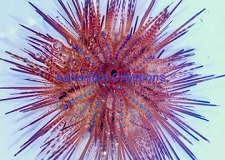
Description:
One of the more rare varieties of Urchins the Lonspine Rainbow Fire Urchin, False Fire Urchin,the Radiating Hatpin Urchin or Blue Spotted Urchin (Astropyga radiata) is a species of sea urchin belonging to the family Diadematidae. These urchins have magnificent coloration, but they can deliver a venomous sting equivalent to that of a bee sting. The spines are long and sharp, constantly moving, and irregularly distributed. Spines usually banded in orange and white, darkening to red towards the tips with radiating rows of electric blue dots decorate its body. In the wild, these urchins play host to a variety of other marine life including commensal shrimp, different types of crabs, and cardinal fish find safety from predators within the urchins' spines during daylight hours. During the day, urchins will find a corner or hiding spot to rest. At night, they will roam about the tank searching for food and algae on the substrate, rockwork, and glass. The most common injuries from urchins happens when the aquarists accidently bumps against an urchin and gets poked by its spines so always take care around your urchin to avoid injuring it or yourself.
The Lonspine Rainbow Fire Urchin makes an excellent algae controller for an aquarium where a normal clean up crew would be eaten, such as more aggressive fish such as the larger wrasses and trigger fish. Provide an aquarium with ample hiding places and room to roam. It is very sensitive to high levels of copper-based medications and will not tolerate high nitrate levels. If it begins to shed its spines, it is a sign of very poor water quality.
Diet and Feeding:
If there is insufficient algae growing in the aquarium for the Urchin to graze on, the diet should be supplemented with dried seaweed.
Reef Compatability:
Excellent will not harm inverts or corals
Level of Care: Easy
Approximate Purchase Size:
2" to 3"
Cautions:
It is very sensitive to high levels of copper-based medications and will not tolerate high nitrate levels. If it begins to shed its spines, it is a sign of very poor water quality. When working within the aquarium please be aware, the spines are venomous, with its sting being roughly equivalent to that of a bee sting.
|
Price Each $49.99
|
Pencil Urchin
Eucidaris tribuloides
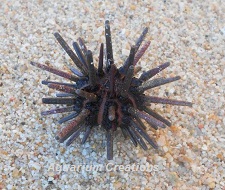
Description:
The pencil urchin, Eucidaris tribuloides, is a sea urchin that inhabits regions of the Atlantic Ocean. The Pencil Urchin, also known as the Slate Pencil Urchin, Club Urchin, or Mine Urchin, is a small reddish brown urchin with pencil-like spines protruding from its body. These spines are thicker than that of other urchins. But like all urchins, they act as a defensive mechanism against predators in nature. The Pencil urchin (Eucidaris tribuloides), is commonly sold in aquarium stores because they are effective at controlling saltwater aquarium and reef tank hair algae issues. During the day, pencil urchins will find a corner or hiding spot to rest. At night, they will roam about the tank searching for food and algae on the substrate,rockwork, and glass. The Pencil Urchin makes an excellent algae controller for an aquarium where a normal clean up crew would be eaten by more aggressive fish such as the larger wrasses and trigger fish. For the Pencil Urchin to do well you must provide an aquarium with ample hiding places and room to roam. It is very sensitive to high levels of copper-based medications and will not tolerate high nitrate levels. If it begins to shed its spines, it is a sign of very poor water quality.
Diet and Feeding:
If there is insufficient algae growing in the aquarium for the Urchin to graze on, the diet should be supplemented with dried seaweed.
Reef Compatability:
Excellent will not harm inverts or corals
Level of Care: Easy
Approximate Purchase Size:
1-1/2" to 3-1/2"
Cautions:
It is very sensitive to high levels of copper-based medications and will not tolerate high nitrate levels. If it begins to shed its spines, it is a sign of very poor water quality.
|
Price Each $19.99
|
Blue Tuxedo Urchin
Mespilia cf globulus
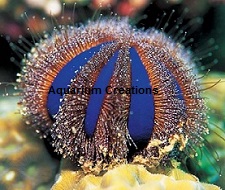
Description:
Easily identifiable by there Blue bands usually blue or black, with red, black, or orange dark spines. Like all urchins, the Blue Tuxedo Urchins are an excellent algae controller for either a reef aquarium or a saltwater fish only aquariums housing aggressive fish. During the day, the Blue Tuxedo Urchin will find a corner or hiding spot to rest. At night, they will roam about the tank searching for food and algae on the substrate, rockwork, and glass. The Blue Tuxedo Urchin makes an excellent algae controller for an aquarium where a normal clean up crew would be eaten by more aggressive fish such as the larger wrasses and trigger fish. For the Tuxedo Urchin to do well you must provide an aquarium with ample hiding places and room to roam. It is very sensitive to high levels of copper-based medications and will not tolerate high nitrate levels. If it begins to shed its spines, it is a sign of very poor water quality.
Diet and Feeding:
If there is insufficient algae growing in the aquarium for the Urchin to graze on, the diet should be supplemented with dried seaweed.
Reef Compatability:
Excellent will not harm inverts or corals
Level of Care: Easy
Approximate Purchase Size:
Small: up to 1", Medium: 1" to 2"; Large: 2" to 3"
Cautions:
It is very sensitive to high levels of copper-based medications and will not tolerate high nitrate levels. If it begins to shed its spines, it is a sign of very poor water quality.
|
Small $32.99
Medium $39.99
Large $49.99
|
Shortspine Urchin
Echinometra mathei
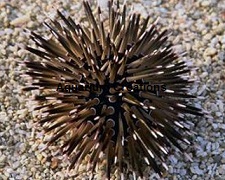
Description:
The Short Spine Urchin grows to a maximum diameter around 3 inches and it has hundreds of uniform reddish-orange colored spines. This species is peaceful by nature and reef compatible â?" it is also fairly easy to keep in the home aquarium as long as you provide plenty of live rock for grazing. The Short-spined Urchin is found on rocky reefs. It is an echinoderm that has tube feet for collecting prey. It also has strong jaws for crushing food. It can actually dig a hole in rock to hide in by day if no hideout is found. It forages near its refuge at night, and then returns to its hole at morning. The Short-spined Urchin will eat hair algae and other forms of algae in an aquarium. Its spines are much smaller and much less sharp than those of the long-spined urchin, Diadema. During the day, the Short Spine Urchin will find a corner or hiding spot to rest. At night, they will roam about the tank searching for food and algae on the substrate,rockwork, and glass. The Short Spine Urchin makes an excellent algae control keeper for an aquarium where a normal clean up crew would be eaten by more aggressive fish such as the larger wrasses and trigger fish.
Diet and Feeding:
If there is insufficient algae growing in the aquarium for the Urchin to graze on, the diet should be supplemented with dried seaweed.
Reef Compatability:
Excellent will not harm inverts or corals
Level of Care: Easy
Approximate Purchase Size:
1-1/4" to 2-1/2"
Cautions:
It is very sensitive to high levels of copper-based medications and will not tolerate high nitrate levels. If it begins to shed its spines, it is a sign of very poor water quality.
|
$11.99
|
Longspine Urchin, Banded
Echinothrix calamari
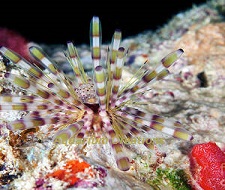
Description:
The Banded Longspine Urchin, is also commonly known within the aquarium trade as either the Longspined Urchin or Hatpin Urchin. It has a dark brown to black central body with alternating brown to black, and white striped spines. These very sharp spines can bbe up to 9 inches long when full grown. Their spines are thick and hollow yet still very strong. Some of the spines are short and less thick in size. The Banded Longspine Urchin lives in the Indo-Pacific reefs, where it spends the daylight hours in dark crevices and comes out at night to feed. During the daytime their are some species of small fish that utilize the spines of Banded Longspine Urchin for protection from larger fish species.
Diet and Feeding:
If there is insufficient algae growing in the aquarium for the Urchin to graze on, the diet should be supplemented with dried seaweed.
Reef Compatability:
Excellent will not harm inverts or corals
Level of Care: Easy
Approximate Purchase Size:
1-1/2" to 3-1/2"
Cautions:
It is very sensitive to high levels of copper-based medications and will not tolerate high nitrate levels. If it begins to shed its spines, it is a sign of very poor water quality.
|
Price Each $31.99
|
Red Tuxedo Urchin
Mespilia globulus
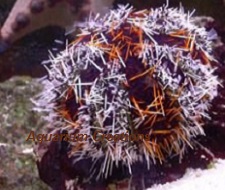
Description:
Easily identifiable by there Red bands usually Red or black, with red, black, or orange dark spines. Like all urchins, the Red Tuxedo Urchins are an excellent algae controller for either a reef aquarium or a saltwater fish only aquariums housing aggressive fish. During the day, the Red Tuxedo Urchin will find a corner or hiding spot to rest. At night, they will roam about the tank searching for food and algae on the substrate, rockwork, and glass. The Red Tuxedo Urchin makes an excellent algae controller for an aquarium where a normal clean up crew would be eaten by more aggressive fish such as the larger wrasses and trigger fish. For the Tuxedo Urchin to do well you must provide an aquarium with ample hiding places and room to roam. It is very sensitive to high levels of copper-based medications and will not tolerate high nitrate levels. If it begins to shed its spines, it is a sign of very poor water quality.
Diet and Feeding:
If there is insufficient algae growing in the aquarium for the Urchin to graze on, the diet should be supplemented with dried seaweed.
Reef Compatability:
Excellent will not harm inverts or corals
Level of Care: Easy
Approximate Purchase Size:
Small: up to 1", Medium: 1" to 2"; Large: 2" to 3"
Cautions:
It is very sensitive to high levels of copper-based medications and will not tolerate high nitrate levels. If it begins to shed its spines, it is a sign of very poor water quality.
|
Small $32.99
Medium $39.99
Large $49.99
|
|
|








